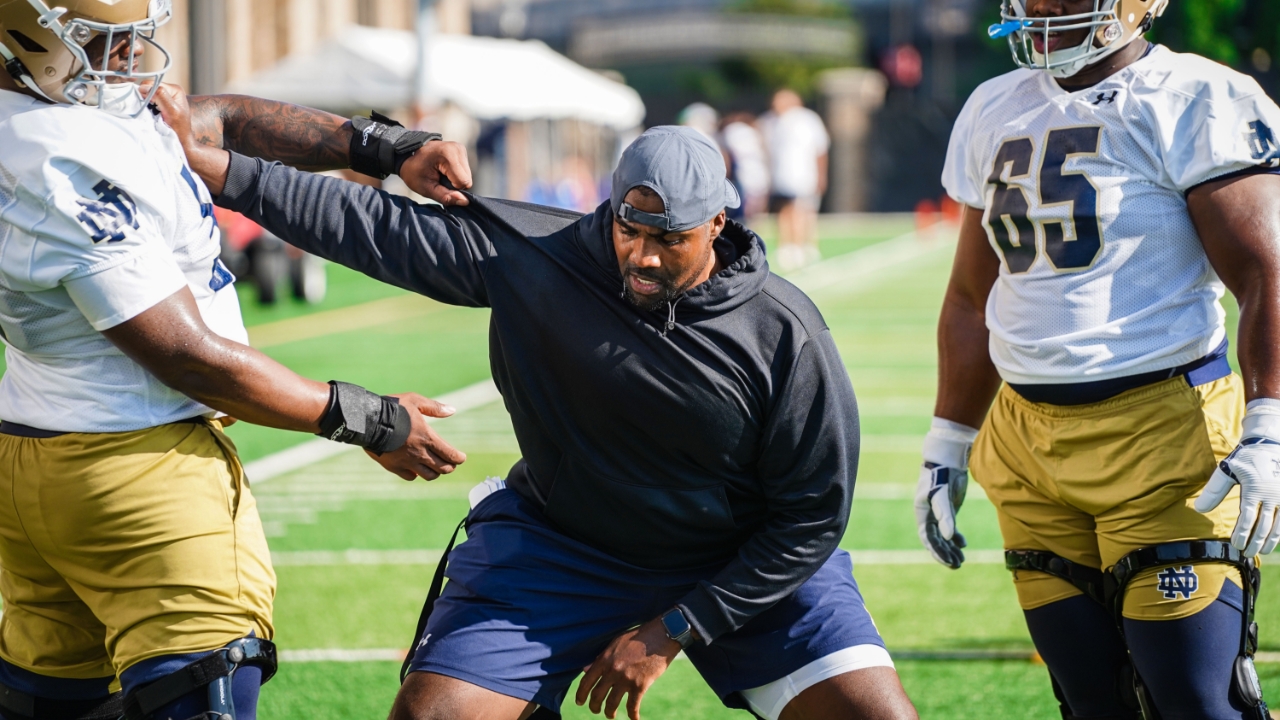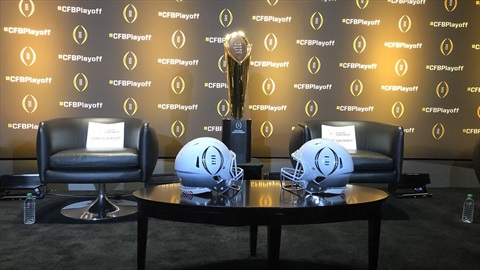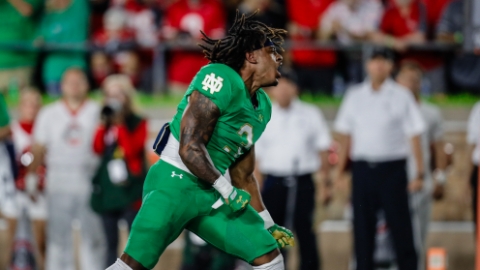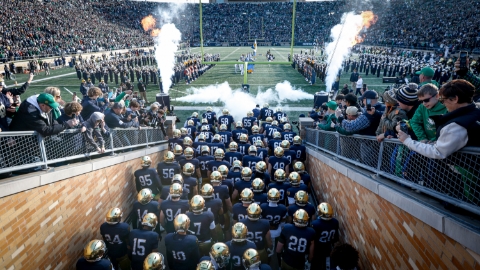
Six days.
That’s how much time is left for players to enter the transfer portal until the next window opens back up in May. That’s not a lot of time before things close up shop for players. They don’t have to make their decisions on where they are going by January 18th, but they do have to make a decision as to whether or not they are going to go.
They can always choose to stay at their current school. Some high profile names have already done so this year. But if they want to pursue another opportunity, they have the next six days to make their move.
That means a couple of things for Notre Dame. For the players that everyone are wondering whether or not they will stay or go, we’ll know within a week if they plan on being enrolled this semester. For the players Notre Dame is looking to add to their roster, if their name isn’t in the portal by the 18th, they can’t be an option until after spring ball.
We’re in the waiting game now. Everyone is waiting to see who might visit this weekend. Everyone is waiting to see what might happen with the few targets we know Notre Dame has interest in who have not yet declared where they are going. Everyone is waiting to see if players who look like they aren’t going to be seeing the field very much for the Irish want to pursue other opportunities.
I think we can say that the latter part of it will take care of itself. There definitely could be more names to enter who were on Notre Dame’s roster last season, but there’s also plenty of individuals who may choose to be at Notre Dame this spring and plan to transfer this summer.
They will be at or under 85 scholarships when it’s time to be under 85 scholarships.
There are still needs to be filled, though. They got their quarterback, help at safety, and at receiver, but they could use more competition at a couple of more positions and the clock is ticking.
What makes the process more interesting (or nerve-wracking) for fans looking for more news is that the accelerated timeline of this transfer window has made news come quickly or not at all.
There aren't as many players tweeting out every offer, although some do. Recruiting and beat reporters, much like coaches, develop relationships with parents, trainers, and players over time which help them find out information about a high school player’s recruitment. With the compressed schedule and plans shifting frequently for transfers, that information isn’t as available.
Notre Dame may be able to pull a defensive linemen or another receiver, it could be that we won’t know it’s going to happen or who it will be until right before a visit or a commitment. Safety Thomas Harper wasn’t on the radar and then all of a sudden he popped on like he deactivated a cloaking device. It can go down that quickly.
Will it go down that quickly for Notre Dame with anyone else? We have six days to find out if it can or if things have been moving quietly behind the scenes with some names we don’t know yet.
When ISD sends out a “BOOM” text about a commitment, those are typically ones we have known would happen for a while. It’s different with most transfers and that makes it a bit more exciting to cover.
2. A few days ago SEC commissioner Greg Sankey called for the end of the early signing period. He said to The Athletic’s Nicole Auerbach:
“We’re crushing coaches in December,” he said Saturday in a wide-ranging conversation with The Athletic two days before the national championship game. “We’re going to add Playoff games (in December). We have to change early signing.”
He’s right. It’s way too much for coaches during that time who have regular recruiting, transfer recruiting, and bowl games to prepare for all at the same time.
The designated window for the transfer portal after the season, December 5th to January 18th, is a mistake too. The intention was supposed to make student-athletes wait and then not make a decision during the season. That didn’t prevent that from happening (see Lacey, Jacob) during the season and the window isn’t long enough if a player is going through bowl practices, a game, and final exams before that.
They need to get rid of this window and the December signing day.
I’m still a believer in players signing early, though. For those who want to, they can sign in August before their senior year starts. For those that aren’t ready, that first Wednesday of February works well again to add some cushion after the already hectic pace of December.
It’s obvious that those making these decisions didn’t think about any of this stuff on top of what the portal dates mean for the coaching carousel. They need to admit their mistake swiftly and change this for next year.
I think everyone involved, including us who cover it, hope that it happens.
3. The 2016 recruiting class featured four defensive ends who would become NFL Draft picks. It also featured a converted linebacker who ended up playing end and then eventually making a 53-man roster in the NFL.
It’s arguably the greatest haul at that position that Notre Dame has ever had. (For anyone who knows of a better one, please throw it in the comments if you can recall one. I’d love to read about it.)
This is how Notre Dame followed that up.
Jonathan MaCollister (after hit after hit in the ‘16 class, a whiff by Keith Gilmore)
Kofi Wardlow (a late take by Mike Elston when he took over the D-line position)
Justin Ademilola (committed to Keith Gilmore and Notre Dame after being offered at a camp)
Isaiah Foskey (BIG hit)
NaNa Osafo-Mensah (hasn’t developed into a starter after four seasons)
Alex Ehrensberger (an intriguing project who hasn’t cracked the rotation)
Jordan Botelho (finally looks like a hit at the end of season three)
Will Schweitzer (moved positions and has been injured)
Devin Aupui (transferred after one semester)
Jason Onye (still in development, moved to defensive tackle)
Aiden Gobaira (redshirted)
That’s the list.
They have had linebackers move to Vyper during that time, but they weren’t specifically recruited by Mike Elston or projected to move there at the time they signed.
They signed three 4-stars in the ‘16 class. They only signed four (Foskey, NaNa, Botelho, and Gobaira) in the next six classes. Notre Dame kept winning games and the defensive ends kept producing, but the sign that things weren’t where they should be at defensive end was in 2021 when Myron Tagovailoa-Amosa had to move to end from defensive tackle then Rylie Mills had to do the same thing the next year.
That says that Notre Dame, in this case it would be Elston, missed with evaluations, landing elite recruits, and development at the position. And I don’t think Elston was/is a bad coach. I just think that talent (physical and athletic traits) are what matters the most on the defensive line and when you miss on talent, coaching can only do so much to make up for it.
The jury is out on Al Washington as a defensive line coach at Notre Dame because development with most of these guys isn’t a one-year deal.
Where is Tyson Ford at in year two and year three? Ditto with Gobaira? Can Washington help develop someone like Josh Burnham into a significant contributor as an edge rusher? That will be what matters the most in the long run as a coach, but in the meantime, Washington just landed four 4-stars in the 2022 class. He has another committed in the 2024 class and I have little doubt he’ll add to that number.
Notre Dame is going to be better in the long term because of this improved recruiting, but now they’re in the process of navigating what Elston did and didn’t do. A big part of that will be hoping that some of the guys Notre Dame just redshirted and the ones they signed in this class can help sooner rather than later.
4. One thing that stood out with the defensive line that I really liked seeing this season was being a bit more strategic about matching personnel. That’s often something that people think of with linebackers and defensive backs in terms of adding or subtracting players at those positions depending on how many tight ends/receivers an offense has on the field, but Notre Dame seemed to do more with run down/pass down up front this season.
That’s part of why we saw Justin Ademilola playing with Isaiah Foskey or Jordan Botelho late rather than replacing them. It’s also why we saw someone like Mills shift so much playing inside and out whether it was determined by the matchup that week or specific personnel on a given play.
In week one against Ohio State, Mills played 90% of his snaps aligned outside as an end. Against Marshall, it was 69.2% aligned as a defensive tackle. Against Cal, he was back outside for over 90%. Then again against North Carolina, it was 77.4% outside.
These two plays against North Carolina always stuck with me the entire season. This is 1st down and Gabriel Rubio and Chris Smith are on the field at defensive tackle with Mills at end. They stuff the run and then get off the field.
On the very next play it’s Mills and Howard Cross inside. Mills runs an E-T with Isaiah Foskey and gets a sack. That’s a call on 2nd and long expecting them to pass.
It’s important to have versatility up front and adjust to tendency and personnel. Sometimes the defensive line rotation gets ignored because there is an old fashioned mindset that this series should be for these four guys until we substitute in another four. It was nice to see Notre Dame not be stuck in that approach this season.
5. With the defensive line in general, I thought the line was good this year.
Not close to great. Not close to bad. Much better than average. They were good, but no better than that.
The problem is that good doesn’t make you an elite defense or give you a shot at winning a national championship. Great is what’s needed.
I’m going to basically plagiarize myself from a message board response yesterday and remind everyone of Notre Dame’s 2017 defensive line.
That line had Jay Hayes and Andrew Trumbetti playing a lot. It had Jerry Tillery playing out of position at nose and Jonathan Bonner starting at 3-tech. A true freshman Myron Tagovailoa-Amosa was the only defensive tackle in the rotation because they literally had no one else. Julian Okwara, Daelin Hayes, and Khalid Kareem all played a lot, but weren’t great players yet as sophomores.
The next year was completely different Okwara, Hayes, and Kareem all taking a jump. Ade Ogundeji joined the rotation. Kurt Hinish joined the rotation. They moved Tillery to 3-tech and Bonner was able to be serviceable inside at nose. That group with those ends in year three and the next year with those ends in their fourth season were great defensive lines.
After finishing 47th in PFF’s pass rush grade in 2017, they finished 4th and 5th the next two seasons. In ‘17 the D-line combined for 47.5 Havoc plays. That number went up to 64.5 in ‘18 and 63 in ‘19.
I don’t need to name every defensive linemen on the current roster, but take a look at who is coming back for Notre Dame and how they are set up this year in terms of years for players they are going to count on. This year’s defensive line resembles the ‘17 one far more than the ‘18 one, but a year from now, that should change.
Not every top recruit is a “hit” and there’s way less “hits” for lower ranked defensive linemen. I think the expectation for the defensive line should be that it’s good in 2023. Anything better than that would surpass any realistic expectations.
Beyond that, I think they have a chance to be great as players develop and mature much like those players did in 2018 and 2019.
6. Sam Hartman is bringing more answers than questions with him to Notre Dame, but there’s always going to be people who are skeptical until he proves himself in a new system and against Notre Dame’s schedule (never mind that Notre Dame plays five ACC teams each year, that ruins their argument).
I think there were some pretty obvious reasons why Hartman chose Notre Dame and most of those have to do with the offense. He had to be thinking how nice it would be to play on a team who is bringing an actual defense, though. In his five seasons at Wake, their defense finished 77th, 63rd, 79th, 76th, and 85th in DF+ (combined FEI and SP+ rating). They won 11 games in 2021 with the 76th ranked defense in the country.
Over that same time, Notre Dame’s average finish in DF+ was 19th.
With what I just wrote about the defensive line and what we know about the questions there are at safety and linebacker, the Irish defense would need a number of things to happen for them to make the jump to being elite. A top-20 defense is certainly achievable and Hartman hasn’t had anywhere close to that to help him out. Most of the heavy lifting had to be done by him and the offense at Wake Forest.
It’s fair to say that there should be higher expectations for the Notre Dame offense next season than the defense, but the weight won’t be all carried by Tommy Rees, Sam Hartman, and company. It’s going to be carried by the defense and special teams as well.
When Wake’s offense turned the ball over last season, the defense gave up points on 61.5% of the following drives. When Notre Dame’s offense turned the ball over, the defense only gave up points on 25% of the following drives. That’s not insignificant and unlike what happened at Wake Forest, the Irish defense often rose to the occasion to prevent things from flipping in the wrong direction after a turnover.
Every quarterback might want to be “the man”, but no one can get away with having to carry a team an entire season. Just ask Caleb Williams about that.
Notre Dame’s quarterback should never have to carry that burden and if that quarterback is Hartman, having a good defense to back him up is only going to help him become a more confident player.
Men's Colosseum Charcoal/Navy Notre Dame Fighting Irish Good On You Raglan Full-Zip Jacket




